Expert gardeners offer advice for a thriving and beautiful garden. Here are some tips:
Knowing the USDA Hardiness Zone can help gardeners select plants that are suitable for their specific area. Pruning shrubs at the right time, such as after the blooms fade, can promote healthy growth and future blooms. Composted manure is an excellent source of organic matter for garden beds, but it’s essential to allow it to cure for at least six months. Understanding the amount of sunlight different plants require and controlling weeds through hand-weeding and mulching are also crucial for a thriving garden.
Key Takeaways:
- Knowing the USDA Hardiness Zone is crucial for selecting suitable plants
- Pruning shrubs at the right time promotes healthy growth and future blooms
- Composted manure provides organic matter for garden beds
- Understanding sunlight requirements and controlling weeds are essential for a thriving garden
Choosing the Right Plants for Your Area
To create a flourishing garden, it’s crucial to choose plants that are suitable for your specific area. This means taking into account your USDA Hardiness Zone, which is determined by the average minimum winter temperature in your region. Avoid planting trees, shrubs, and perennials that won’t survive winters in your area.
Understanding your growing season is also important. Some plants, such as tomatoes and peppers, require a long growing season, while others, like lettuce and radishes, can be grown in cooler weather. Consider the amount of sunlight different plants need as well. Some vegetables, like tomatoes and cucumbers, need full sun to thrive, while others, such as lettuce and spinach, can grow in partial shade.
Providing healthy soil with organic matter is essential for plant growth. Composted manure is a great source of organic matter and can be mixed into garden beds. Balancing watering and fertilization is also crucial. Overwatering can lead to root rot, while under watering can cause plants to wilt.
Controlling pests and diseases naturally is important for plant health. Neem oil and insecticidal soap are effective natural remedies for common garden pests. Harvesting crops at the right time is also key. Vegetables should be harvested when they are mature to ensure the best flavor and texture.
Finally, take time to enjoy your garden. Gardening is a process that requires patience and regular maintenance. By following these tips and choosing plants that are suitable for your area, you can create a thriving and beautiful garden that will bring you joy for years to come.
The Art of Pruning for Healthy Growth and Blooming
Proper pruning is essential for maintaining the health and beauty of your garden. As a gardener, I understand that pruning can be daunting, but by following a few simple guidelines, you can ensure healthy growth and blooming in your garden.
For spring-flowering shrubs like lilacs, it is important to prune them immediately after the blooms fade. This will ensure optimal growth and promote future blooms. Deadheading, or removing spent flowers, is a good practice for perennials and annuals, as it encourages the plant to produce more flowers and directs its energy towards stronger growth. However, it is not recommended to deadhead plants grown for decorative fruits or pods.
Understanding the amount of sunlight different plants need is crucial, as most vegetables require at least 8 hours of direct sunlight every day for the best harvest. Weeding is also an essential part of maintaining a healthy garden, and it is best done using natural methods such as hand-weeding and hoeing. Dividing certain plants, like hostas, can help rejuvenate them or increase their numbers. It is best to divide hostas in the spring or fall, depending on the new shoots appearing or before the leaves unfurl.
It is also important to know the optimal temperature for ripening tomatoes, which is between 68-77°F, as higher temperatures can prevent the production of pigments responsible for fruit color. Other tips include planting spring-blooming bulbs in the fall, leaving ornamental grasses and seed heads of perennials in the garden in the fall, and paying attention to soil quality and nutrient content.
By following these gardening techniques and plant care advice, you can ensure healthy growth and blooming in your garden.
The Power of Composted Manure
Boost your garden’s health by incorporating composted, rotted manure into your soil. According to Source 1, it is crucial to apply only composted, rotted manure that has cured for at least six months to the soil. Fresh manure is high in nitrogen and can burn plants, while also potentially containing pathogens or parasites.
Source 2 emphasizes the importance of starting with healthy soil by adding organic matter such as compost or manure to improve soil health and drainage. By boosting soil quality, plants can establish strong roots and maintain good health.
Source 3 mentions that organic matter, like compost, shredded leaves, or composted manure, can be added to the soil to enrich it and provide necessary nutrients to plants. Overall, composted manure is a valuable resource for gardeners as it helps improve soil fertility and provides essential nutrients for plant growth.
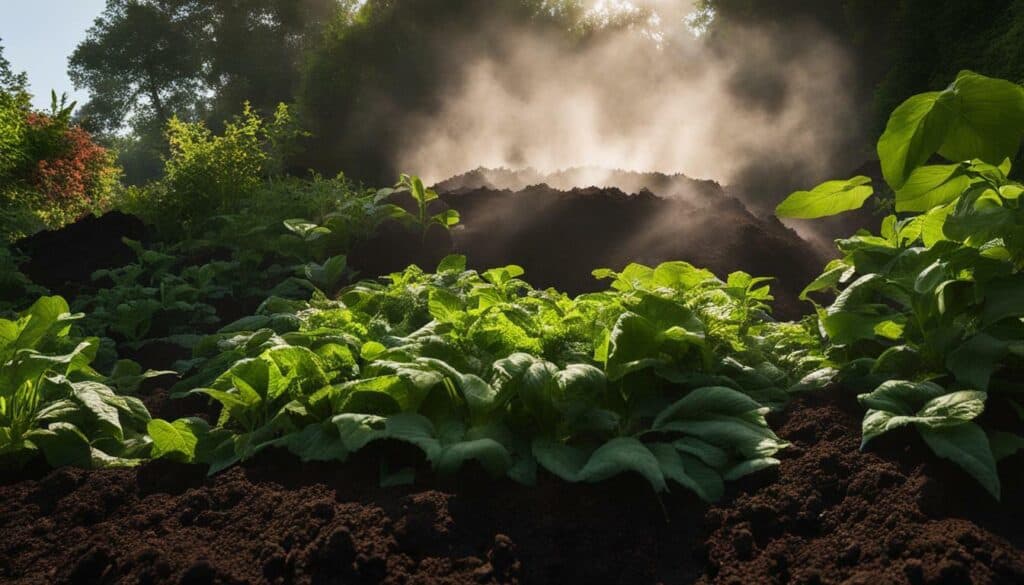
| Benefits of Composted Manure | How to Apply Composted Manure |
|---|---|
| Enriches soil with essential nutrients | Mix into soil before planting or top-dress around existing plants |
| Improves soil fertility and structure | Apply in the fall or spring and water thoroughly |
| Increases moisture retention | Avoid applying to areas with standing water or plants that prefer dry soils |
Patience with Perennials
Growing perennials requires patience, but the results are well worth it. These plants typically take around three years to reach their mature size after planting and go through a cycle of “sleep, creep, and leap” each year. It’s important to understand the growing season in your area to ensure you’re planting at the optimal time.
Deadheading, or removing spent flowers from perennials and annuals, allows the plants to produce more flowers and use their energy for growth instead of seed production. Understanding the lighting needs of different plants is crucial. Most vegetables require at least 8 hours of direct sunlight per day, while cool-season crops like lettuce and radishes tolerate shade.
Weeds can be controlled through hand-weeding and hoeing, and mulch can help smother and prevent them. Dividing perennials like hostas is not always necessary unless you want to rejuvenate the plant or increase the number of plants. Hydrangeas can grow in full sun, such as the panicle hydrangea variety. It’s also important to leave some cleanup tasks for the fall to provide beauty and food for birds.
Spring-blooming bulbs can be planted in the fall, and deadheading these bulbs can stimulate new growth. Soil quality is more important than fertilizer for growing plants, and organic amendments like compost and well-aged manure can improve soil structure. Dividing and transplanting spring-blooming perennials is best done in late summer or early autumn.
Rhubarb should have its flower stalks removed to focus on foliage production. Proper planting techniques, such as digging a hole twice the size of the soil ball for transplanting, should be followed. Potatoes should be stored in complete darkness to prevent the development of solanine, a bitter-tasting toxin. In-ground garden plants typically require 1-2 inches of water per week, and watering deeply once a week is more effective than frequent, shallow watering. Fall leaves can be chopped up and used as compost.
Overall, gardening requires patience and taking care of your garden little by little to achieve a flourishing and beautiful result.
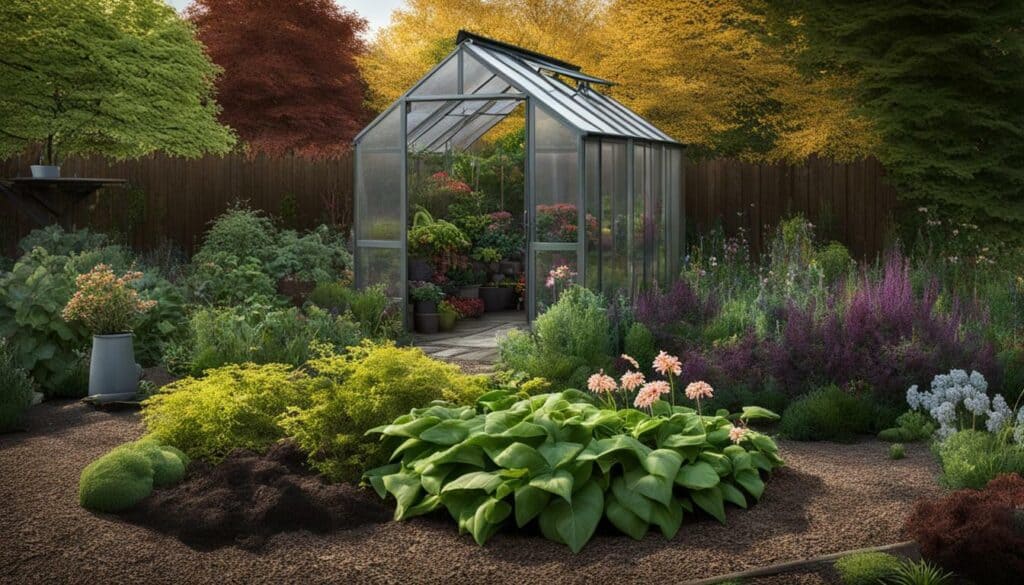
Timing is Everything
Understanding your growing season is essential for successful gardening. Knowing your USDA Hardiness Zone is a crucial first step in selecting plants that will thrive in your specific area. Spring and fall are the best times to divide hostas, and pruning should be done after the blooms fade to avoid removing next spring’s flower buds.
Timing is also important when transplanting perennials. Wait until the plant is dormant and has lost its leaves before transplanting to minimize shock and increase the chances of success.
When it comes to vegetable gardening, paying attention to light requirements is crucial. Most vegetables require at least six hours of direct sunlight per day to grow and mature properly. However, cool-season crops like lettuce and spinach can be planted in shaded areas, providing a longer growing season and helping to prevent bolting.
Timing is also important for ripening tomatoes. The optimal temperature for ripening is 68-77°F, and it’s essential to pick the fruit at the right time to promote further growth.
Controlling weeds through hand-weeding and hoeing is best. Applying a layer of mulch around plants can also help suppress weed growth and retain moisture in the soil.

Patience is key when it comes to gardening. Start with easy-to-grow plants to ensure success, and water consistently to promote healthy growth. Regular maintenance, such as deadheading and pruning, will also help keep your garden looking beautiful.
Enjoying the garden and sharing the produce with others adds to the overall experience. Start by planning your garden and preparing the soil. Don’t forget to consider the specific needs of your region, and don’t be afraid to ask local experts for their advice. Gardening can be a relaxing and rewarding hobby, as long as you’re willing to be patient and put in the necessary effort.
The Art of Deadheading
Deadheading is a simple technique that can significantly improve the health and appearance of your garden. By removing spent blooms, deadheading encourages plants to produce more flowers and directs their energy towards leaf growth and root development. However, it is important to avoid deadheading plants that are grown for decorative fruits or pods.
Understanding the sunlight requirements of different plants and providing adequate water is crucial for a flourishing garden. It is also essential to control weeds through hand-weeding and hoeing, divide and transplant perennials, and harvest crops at just the right time. By planning your garden, preparing the soil with organic matter, and selecting plants suited for your region and climate, you can improve your chances of gardening success.
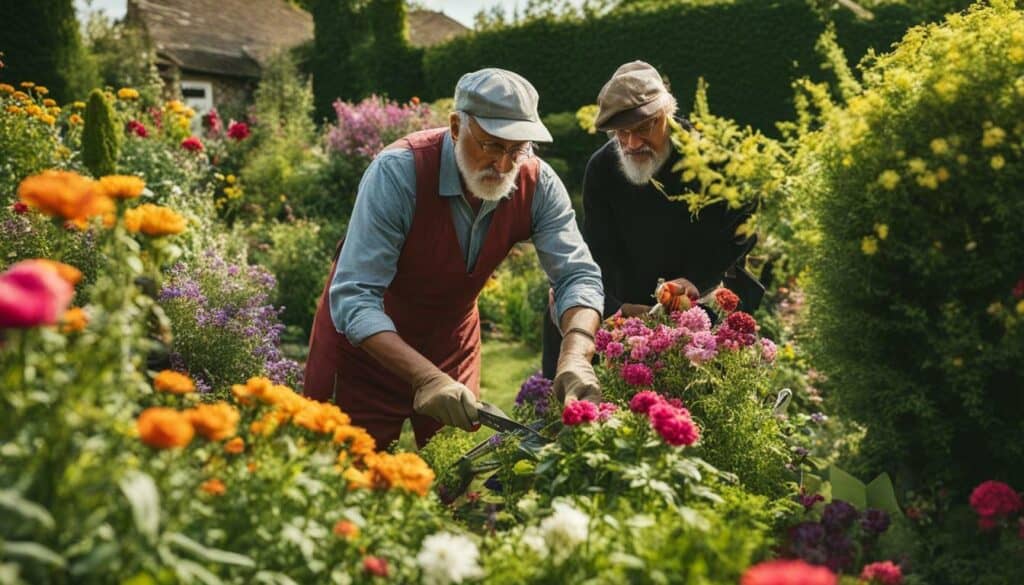
Don’t forget to take care of pests and diseases naturally, enjoy the fruits of your labor, and start small. In gardening, patience and perseverance are virtues as it takes time for a garden to flourish.
Sunlight and Shade Considerations
Understanding sunlight and shade requirements is crucial for maximizing plant growth and productivity. When planning your garden, it’s important to know the sun exposure requirements of different plants and ensure they are planted in suitable locations. For example, vegetables need at least 8 hours of direct sunlight daily, while shade-loving plants can thrive in areas with limited sun exposure.
In addition to considering the individual needs of plants, it’s also necessary to have a basic understanding of the region’s climate. Certain plants thrive in specific climates, while others may not be suitable for the area. Choosing plants that are well-suited to your region can help ensure their success in your garden.
Another key factor in ensuring optimal plant growth is healthy soil. Plants require well-draining soil that is rich in organic matter. Organic matter can be added to the soil in the form of compost or other organic amendments. By improving the quality of the soil, you can create a more hospitable environment for your plants.
When it comes to watering, it’s important to water the soil rather than just the surface of the plant. This can help ensure that the roots are receiving sufficient moisture and nutrients. Consistency is key when it comes to watering, and it’s important to monitor the soil to ensure that it remains moist.
Regular maintenance is also essential for a thriving garden. This includes tasks such as pruning, deadheading, and weeding. By removing dead or damaged growth, you can promote healthy new growth and prevent the spread of disease. Regular weeding can help reduce competition between plants and ensure that they have sufficient access to nutrients and sunlight.
Finally, it’s important to be patient when it comes to gardening. Growing and maintaining a garden is a process that takes time and persistence. By taking the time to understand the needs of your plants and providing them with the care they require, you can create a beautiful and productive garden that will provide enjoyment for years to come.

Weed Control and Mulching
Keeping weeds at bay is essential for maintaining a beautiful and well-maintained garden. Hand-weeding and hoeing are effective methods for controlling weeds in the garden. However, mulching has proven to be a valuable technique for preventing annual weeds from growing. Applying a 2-3 inch layer of organic mulch, such as shredded leaves, straw, or wood chips, around plants helps to smother and prevent annual weeds from taking root.
When it comes to maintaining soil health, composted, rotted manure is a great choice for amending garden beds. While fresh manure is high in nitrogen, caution should be taken as it can contain potential pathogens or parasites. It is crucial to ensure that the manure has cured for at least six months before it is added to the soil.
Perennials are wonderful additions to any garden. However, it is important to be patient with them as they can take up to three years to reach their mature size. Deadheading perennials and annuals is a good practice as it stimulates the plants to produce more flowers and keeps them looking tidy. Spring-flowering shrubs, such as lilacs, should be pruned immediately after the blooms fade to ensure healthy growth and promote future blooms.
Knowing the amount of light different plants require is crucial for a thriving garden. Most vegetables require at least 8 hours of direct sunlight daily. Trees, shrubs, and perennials should be selected based on their suitable USDA Hardiness Zone to avoid planting varieties that won’t survive the winters. Hydrangeas need sun for their best flowering.
For optimal tomato ripening, keep the temperature between 68-77°F. Potatoes should be buried deep under the soil to avoid exposure to light, which can cause them to turn green and produce toxins. When transplanting container-grown perennials, ensure that the plant is at the same depth as it was in the container. Spring-blooming bulbs should be planted in the fall before the ground freezes, and spent flowers on these bulbs should be deadheaded. Late summer or early autumn is the best time to divide and transplant spring-blooming perennials. Rhubarb flower stalks should be removed so that the plant focuses on foliage production.
Fertilizing is important, but soil quality is more crucial. Organic amendments like compost and well-aged manure should be added to the soil. Most in-ground garden plants require about 1 to 2 inches of water per week. Fall leaves can be chopped up and used as compost ingredients. Harvesting crops at the right time stimulates further growth and prevents overcrowding. Pests and diseases should be controlled using natural methods.
Overall, proper planning, soil preparation, watering, and feeding plants with nutrients are essential for a healthy garden. Lastly, enjoying the garden and sharing its produce with others foster a sense of appreciation for the outdoors.
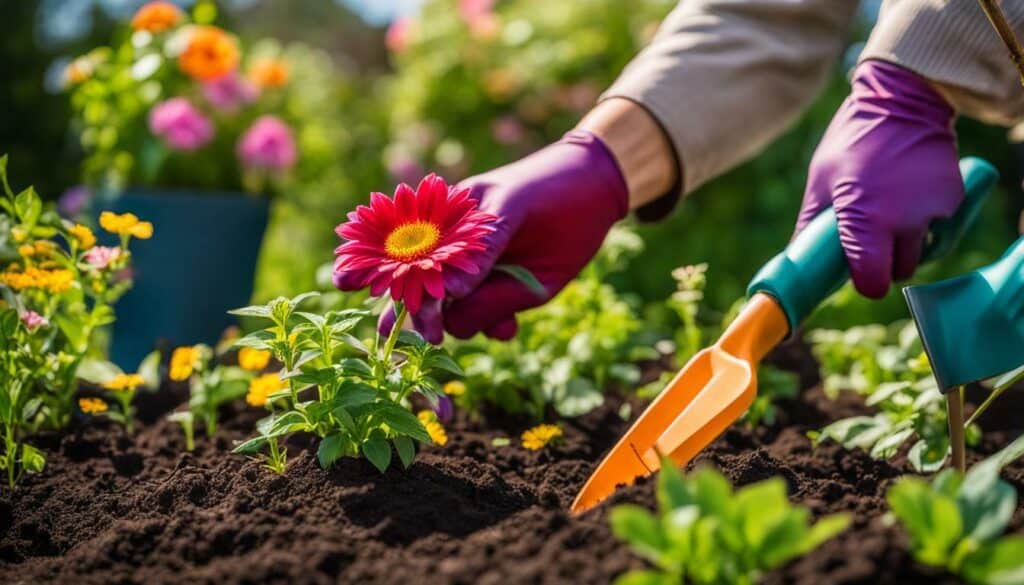
Final Touches and Gardening Enjoyment
Remember to take time to plan, prepare, and enjoy your garden to the fullest. Understanding your growing season and the sunlight requirements of different plants is crucial for a healthy and beautiful garden.
Pruning spring-flowering shrubs immediately after the blooms fade can promote new growth and future blooms. Applying composted manure to the soil can provide essential nutrients for your plants. Deadheading perennials and annuals can promote more flower production.
Controlling weeds through hand-weeding and mulching techniques is important for maintaining a healthy garden. Dividing hostas in the spring or fall and planting bulbs in the fall before the ground freezes are key aspects of gardening.
Soil quality is essential for a thriving garden. Using organic amendments like compost, rotten manure, or worm castings are great options for improving soil health.
Harvesting crops at the right time is crucial for optimal flavor and nutrition. Taking the time to enjoy your garden, whether it’s picking a bouquet of flowers or savoring homegrown produce, is one of the most rewarding aspects of gardening.
A flourishing garden requires attention to detail and patience. Focusing on planning, preparing, and enjoying your garden will ensure a successful and enjoyable gardening experience.
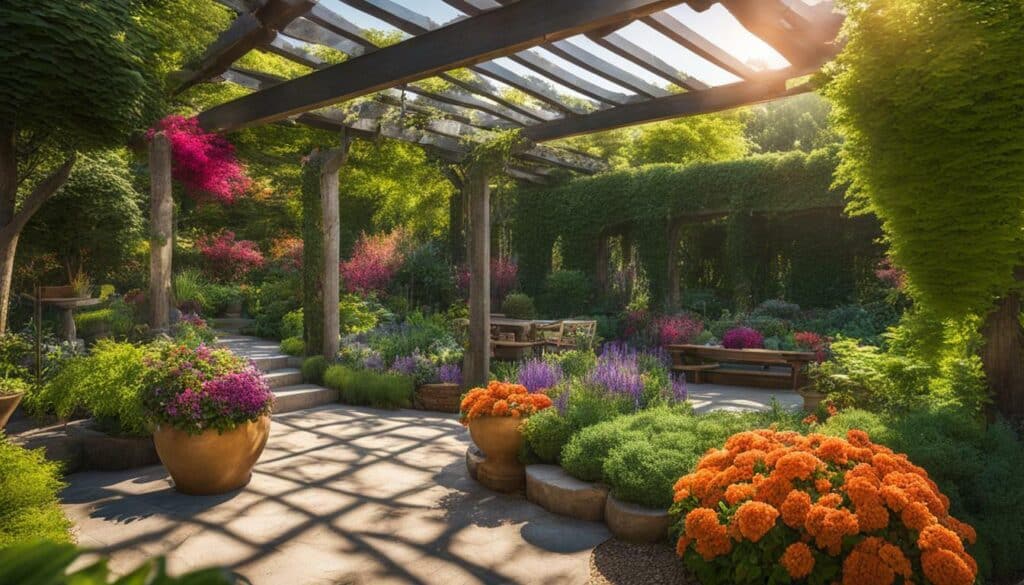
“Gardening is a labor full of tranquility and satisfaction; natural and instructive, and as such contributes to the most serious contemplation, experience, health and longevity.” – John Evelyn
Conclusion
With the expert advice of experienced gardeners, you can transform your yard into a thriving and beautiful sanctuary. Gardening is more than just a hobby – it is a way of life that brings you closer to nature and provides a sense of accomplishment.
To create a healthy garden, it is important to start with a plan and choose the right plants for your area. Understanding the timing and duration of your growing season will help you make informed decisions about when to plant and when to harvest. Proper soil preparation, water management, and pest control are also essential for a thriving garden.
Don’t be discouraged if you are a beginner. Start small and choose easy-to-grow plants. As you gain experience, you can try more challenging plants or experiment with different techniques. Consistency and patience are key in maintaining a flourishing garden. Remember to take the time to enjoy your garden and share it with others.
In conclusion, gardening is a rewarding and enjoyable hobby that can bring beauty and fresh produce to your home. By following these tips, you can create a beautiful and healthy garden that will thrive throughout the season. With dedication and effort, your garden can bring joy and satisfaction to your outdoor space.
What are some tips for creating a beautiful and serene garden space?
Creating a beautiful and serene garden space requires thoughtful planning and attention. To achieve this, consider incorporating elements such as calming water features, lush greenery, and fragrant blooms. Proper maintenance and regular pruning will keep your garden vibrant. The complete gardens guide inspiring serenity can provide valuable tips and ideas for enhancing your outdoor oasis.
What Are Some Tips for Creating a Thriving and Beautiful Garden?
To achieve a thriving and beautiful garden, here are some expert tips for greener gardening. First, choose plants suitable for your climate and soil conditions. Implement organic gardening practices to minimize the use of synthetic fertilizers and pesticides. Regularly water your plants deeply, preferably in the morning. Mulching helps retain moisture and suppress weeds. Lastly, proper pruning and regular maintenance will ensure a visually appealing and healthy garden.
FAQ
Q: What should I consider when choosing plants for my garden?
A: It’s important to know your USDA Hardiness Zone and select plants that can thrive in your specific area.
Q: When should I prune my spring-flowering shrubs?
A: It’s best to prune them after the blooms fade to avoid removing next year’s flower buds.
Q: What type of manure should I use in my garden?
A: Composted, rotted manure that has cured for at least six months is ideal to avoid burning plants and prevent pathogens.
Q: How long does it take for perennials to reach their mature size?
A: Perennials typically need three years to reach their mature size, so be patient with their growth.
Q: How do I know when to start plants indoors?
A: It’s important to be aware of your growing season and start plants inside or avoid growing them if necessary.
Q: Why should I deadhead perennials and annuals?
A: Deadheading helps to encourage more flower production and stronger growth in plants.
Q: How much sunlight do vegetables need?
A: Vegetables require sufficient sunlight, and it’s also worth considering planting cool-season crops if there is shade.
Q: How can I control weeds in my garden?
A: Weed control can be achieved through hand-weeding and hoeing, and using mulch to smother annual weeds.
Q: When should I divide hostas?
A: Hostas can be divided in spring or fall for rejuvenation or to increase their numbers.
Q: Do all hydrangeas grow in shade?
A: No, some hydrangeas require sun for the best flowering.
Q: Should I leave plants and foliage in the garden during fall?
A: Yes, leaving some plants and foliage in the garden during fall adds beauty and provides food for birds.
Q: How can I ensure proper ripening of tomatoes?
A: It’s important to maintain proper temperatures for ripening tomatoes, avoiding extreme heat or cold temperatures.
Q: When should I plant spring-blooming bulbs?
A: Spring-blooming bulbs should be planted in the fall, ensuring proper planting depth and considering perennial tulips.
Q: What should I do with the foliage of spring-blooming bulbs?
A: It’s recommended to deadhead the bulbs and leave the foliage until it turns brown to store nutrients for next year’s growth.
Q: Should I rely solely on fertilizers for soil improvement?
A: It’s best to focus on improving soil quality with organic amendments rather than relying solely on fertilizers.
Q: When should I divide and transplant spring-blooming perennials?
A: Spring-blooming perennials can be divided and transplanted in late summer or early autumn.
Q: Should I remove flower stalks from rhubarb?
A: Yes, removing flower stalks from rhubarb redirects plant energy towards foliage production.
Q: How should I transplant container-grown perennials?
A: Transplant container-grown perennials at the same depth as in the container and avoid using bagged soil.
Q: How should I store harvested potatoes?
A: To prevent solanine production, store harvested potatoes in complete darkness.
Q: How much water do in-ground garden plants need?
A: It’s recommended to provide 1 to 2 inches of water per week through deep watering.
Q: Can I use fall leaves as compost?
A: Yes, you can chop up fall leaves and use them as compost ingredients rather than disposing of them.
Source Links
- https://www.lancasterhomes.ca/green-thumbs-up-expert-gardening-tips-for-a-flourishing-garden/homeowner-hints/
- https://deckers-nursery.com/garden-learning-center/10-tips-to-make-your-garden-flourish/
- https://www.bhg.com/gardening/yard/garden-care/gardening-tips-for-every-gardener/
- https://www.epicgardening.com/become-better-gardener/
- https://www.thegardencontinuum.com/blog/choose-the-right-plant-for-the-right-place-in-your-landscape
- https://www.realhomes.com/advice/how-to-choose-plants-for-your-garden
- https://www.gardenersoasis.com/pick-the-right-plants/
- https://www.bhg.com/gardening/trees-shrubs-vines/care/what-to-prune-when/
- https://www.finegardening.com/article/pruning-tips-and-techniques
- https://joegardener.com/podcast/138-why-pruning-matters-principles-recommendations-and-tips-from-the-pruners-bible/
- https://extension.usu.edu/yardandgarden/research/sustainable-manure-and-compost-application
- https://www.familyhandyman.com/article/what-is-composted-manure/
- https://www.gardeners.com/how-to/all-about-composting/5061.html
- https://newlywoodwards.com/perennial-gardens-exercise-patience-planning/
- https://www.americanmeadows.com/content/worth-the-wait-perennials-that-require-patience
- https://www.wildworksofwhimsy.com/blog/the-patient-gardener
- https://kctomatotimes.wordpress.com/2013/05/26/timing-is-everything-when-it-comes-to-successful-gardening/
- https://canterburycreekgardens.com/2018/05/13/in-gardening-timing-is-everything/
- https://www.nola.com/entertainment_life/home_garden/timing-is-everything-with-vegetable-gardening-and-well-show-you-the-correct-calendar/article_18888036-834d-11ea-a457-b762c8091082.html
- https://www.bloomingsecrets.com/blog/the-art-of-deadheading-is-important-to-know
- https://www.rhs.org.uk/garden-jobs/deadheading-plants
- https://www.gardensillustrated.com/garden-advice/how-to/deadheading
- https://www.summerwindsnursery.com/az/inspire/blog/guide-to-mapping-garden-sun-exposure/
- https://solarpower.guide/sun-exposure-gardeners
- https://www.rhs.org.uk/garden-design/shade-gardening
- https://extension.uga.edu/publications/detail.html?number=C1144&title=weed-control-options-for-the-home-vegetable-gardener
- https://www.finegardening.com/project-guides/gardening-basics/six-tips-for-effective-weed-control
- https://www.gardeners.com/how-to/weed-control/5004.html
- https://theenglishgarden.telegraph.co.uk/expert-advice/gardeners-tips/finishing-touches-garden/
- https://www.nourishingpursuits.com/garden/top-eight-common-mistakes-gardening-make-avoid/
- https://www.gardenersworld.com/how-to/grow-plants/gardening-for-beginners-10-tips/
- https://www.ncbi.nlm.nih.gov/books/NBK373975/
- https://forum.powerscore.com/viewtopic.php?t=14866

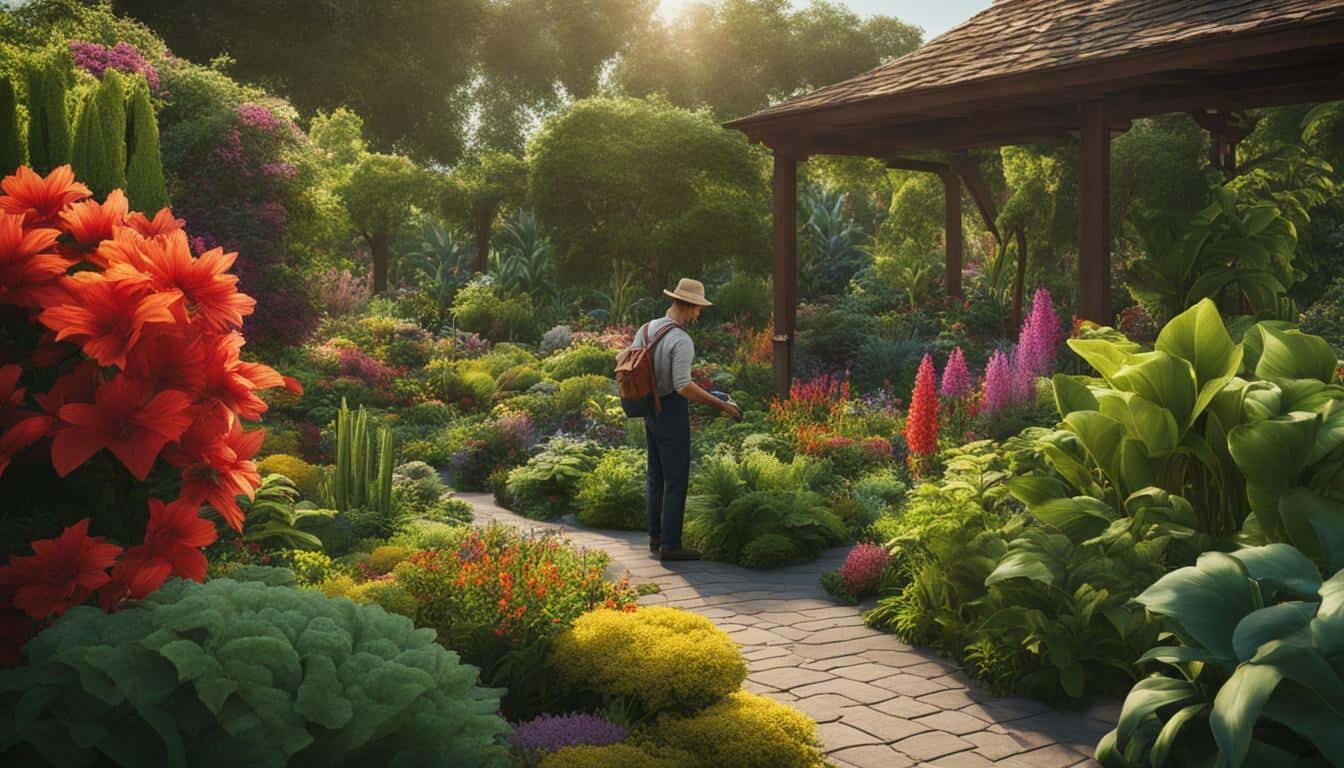



Leave a Reply